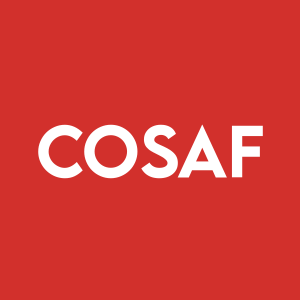Cosa Reports ANT Survey Results from the Ursa and Orion Uranium Projects, Athabasca Basin, Saskatchewan
Rhea-AI Summary
Cosa Resources (OTCQB: COSAF) has reported results from ambient noise tomography (ANT) surveys at its Ursa and Orion uranium projects in Saskatchewan's Athabasca Basin. The surveys identified significant target areas characterized by kilometer-scale ANT velocity anomalies. At Ursa, two high-priority targets (U1 and U2) were identified along the 27-kilometer Kodiak trend, with initial drilling at U1 intersecting over 100 meters of continuous sandstone alteration and weak uranium mineralization. At Orion, three priority targets (O1, O2, and O3) were identified, each showing promising structural characteristics and measuring approximately 1.6-1.8 kilometers in length.
The company plans to conduct ground EM surveying at Ursa and reinterpret historical electromagnetic surveys at Orion before finalizing drill targets. Cosa's immediate focus will be on an expanded summer drill program at the Murphy Lake North Joint Venture, following encouraging results from winter 2025.
Positive
- ANT surveys successfully identified multiple large-scale target areas at both Ursa and Orion projects
- Initial drilling at Ursa's U1 target validated the ANT approach with uranium mineralization discovery
- Ursa project has 65-kilometer-long exploration space potential for multiple tier-1 deposits
- Company's exploration strategy combining ANT and EM surveys proves effective in producing lower risk drill targets
Negative
- Only weak uranium mineralization has been found in drilling so far
- Additional ground EM surveying required before follow-up drilling can begin
- Detailed timing for follow-up work at Ursa and Orion remains uncertain
Vancouver, British Columbia--(Newsfile Corp. - May 28, 2025) - Cosa Resources Corp. (TSXV: COSA) (OTCQB: COSAF) (FSE: SSKU) ("Cosa" or the "Company") is pleased to report results from ambient noise tomography ("ANT") surveys at the Company's
Highlights
Target areas characterized by kilometre-scale ANT velocity anomalies that span the unconformity have been identified at Ursa and Orion and may reflect significant uranium bearing hydrothermal systems
Drilling on trend with all target areas has intersected weak uranium mineralization, altered and geochemically enriched structural zones, and graphitic basement rocks; features consistently found near all tier-1 deposits in the eastern Athabasca Basin
Cosa provides update on summer exploration plans, including follow up drilling at the Murphy Lake North Joint Venture
Andy Carmichael, Vice President Exploration, commented: "Cosa's strategy of using large-scale ANT surveys to prioritize conductive strike led to the strongest and widest intersection of uranium mineralization on the Ursa Project from Cosa's first drill hole to test an ANT target. With only 21 drill holes completed within the 65-kilometre-long Project, Ursa has vast underexplored and increasingly prospective exploration space to fit multiple tier-1 deposits, and we have demonstrated that modern geophysical surveys can produce lower risk drill targets than conventional electromagnetic (EM) surveys alone. Target generation EM and ANT work at Orion has also identified compelling target areas on trend with known mineralization and highly prospective geology."
Ambient Noise Tomography
ANT is a cost effective and low impact geophysical method that uses data collected from a grid of sensors to produce a three-dimensional model of subsurface seismic wave velocity. The Athabasca sandstone is relatively homogenous, and prospective structural disruption and hydrothermal alteration associated with the region's uranium deposits can cause seismic velocity anomalies. Recent exploration drilling in the Athabasca Basin region targeting ANT anomalies has intersected zones of hydrothermal alteration, including drilling at Cosa's Ursa project.
Ursa
ANT surveying at Ursa covered the 27-kilometres of Kodiak trend hosting all four weakly mineralized drill holes within the Project (Figure 2). Interpretation has highlighted two high-priority target areas along the mineralized trend.
U1 is a prominent low velocity anomaly located above strongly conductive basement mapped by Cosa's previous EM surveys. U1 has been tested by a single drill hole, UR24-06, which intersected over 100 metres of continuous sandstone alteration including a 65-metre-long zone with intervals of lost core, desilicification, and locally increased uranium content (see Cosa's news release dated 30 October 2024). UR24-06 also intersected several intervals of weak uranium mineralization in the basement. These results validate the Company's approach of using ANT to prioritize conductive strike length for drill testing. Further follow up is warranted.
The U2 low velocity anomaly is rooted in the basement and extends into the overlying sandstone. U2 is approximately 2 kilometres long and located above the eastern flank of the Kodiak conductive trend. Historical surveying mapped a basement EM conductor trending through the U2 anomaly. CR-04, the single historical drill hole proximal to U2, intersected several zones of lost core and fracturing in medial to lower sandstones with illite and uranium enrichment.
Orion
ANT surveying at Orion targeted an area of interpreted structural complexity between the eastern extension of trends hosting weak uranium mineralization on Orano's neighboring Parker Lake Project, and the interpreted western extension of the east-west oriented magnetic low trend hosting the Cigar Lake Mine and Tucker Lake Zone. Three priority target areas were identified (Figure 3).
The O1 target is a low velocity anomaly extending from the basement into the overlying sandstone. O1 is favourably located above a flexure in a conductive basement trend which parallels a magnetic high. ANT and historical airborne electromagnetic (EM) results suggest an east-west oriented structure trending through the area. Target O1 measures approximately 1,700 by 800 metres.
The O2 target is also a vertically extensive low velocity anomaly and is interpreted as located over the intersection of an east-west trending structure with a basement conductive trend. Target O2 is situated along a splay from the conductive trend hosting Target O1 and measures approximately 1,800 by 900 metres.
Target O3 is a low velocity anomaly located where the interpreted O2 structure intersects the western flank of the basement conductive trend. O3 is a prominent velocity anomaly spanning the unconformity and measuring approximately 1,600 by 700 metres.
Next Steps
ANT surveys have been successful in identifying targets and prioritizing conductive strike for follow-up. At Ursa, ground EM surveying is required to further refine targets prior to follow-up diamond drilling. At Orion, Cosa intends to complete a reinterpretation of historical airborne and ground electromagnetic surveys to determine if additional ground EM surveys are warranted to finalize drill targets. Detailed timing for follow up work has yet to be determined as the Company's near-term focus remains on returning to the Murphy Lake North Joint Venture for an expanded summer drill program to follow up on encouraging results from the winter 2025 drill program.
2025 Summer Exploration
Cosa will be very active this summer with planned drilling at the Murphy Lake North Joint Venture, geophysics at Cosmo and Orion, and target generation at the Darby Lake Joint Venture. More details will be provided in the coming weeks.
Figure 1 - Cosa Projects
To view an enhanced version of this graphic, please visit:
https://images.newsfilecorp.com/files/9865/253571_9654e2fba481bb01_003full.jpg
Figure 2 - Ursa Lower Sandstone ANT Results
To view an enhanced version of this graphic, please visit:
https://images.newsfilecorp.com/files/9865/253571_9654e2fba481bb01_004full.jpg
Figure 3 - Orion Lower Sandstone ANT Results
To view an enhanced version of this graphic, please visit:
https://images.newsfilecorp.com/files/9865/253571_9654e2fba481bb01_005full.jpg
About Cosa Resources Corp.
Cosa Resources is a Canadian uranium exploration company operating in northern Saskatchewan. The portfolio comprises roughly 237,000 ha across multiple
In January of 2025, the Company entered a transformative strategic collaboration with Denison Mines that has secured Cosa access into several additional highly prospective eastern Athabasca uranium exploration projects. As Cosa's largest shareholder, Denison gains exposure to Cosa's potential for exploration success and its pipeline of uranium projects.
Cosa's award-winning management team has a long track record of success in Saskatchewan. In 2022, members of the Cosa team were awarded the AME Colin Spence Award for their previous involvement in discovering IsoEnergy's Hurricane deposit. Prior to Hurricane, Cosa personnel led teams or had integral roles in the discovery of Denison's Gryphon deposit and 92 Energy's GMZ zone and held key roles in the founding of both NexGen and IsoEnergy.
The Company's core focus throughout 2025 is drilling at the Murphy Lake North Joint Venture. Murphy Lake North is a 70/30 Joint Venture between Cosa and Denison respectively and is located at the northern end of the Larocque Lake trend. The Project is within three kilometres of and on trend with the Hurricane deposit. Initial drilling completed by Cosa during winter 2025 intersected broad zones of hydrothermal alteration of the sandstone, associated with prospective basement structures interpreted as the strike extension of those controlling the Hurricane deposit. An expanded follow up campaign is currently in planning for the summer season.
Technical Disclosure
Historical drilling results in CR-04 are available within the Saskatchewan Mineral Assessment Database (SMAD) reference 74G16-0008. Relogging of CR-04 has not been completed by Cosa as the cores have been destroyed by wildfire. Historical EM results referred to from Ursa are from SMAD references 74G09-0005, 74G16-0007 and 74G16-0008. Historical EM results have not been verified as digital data are not available, and these sources have been relied on only for qualitative purposes.
Historical drilling results from the Tucker Lake Zone and the Parker Lake Project were sourced from SMAD references MAW02121, MAW02291, 74H14-0021, 74I02-0031, and 74I02-0051. Verification of Parker Lake drilling results included reviewing core photos, drill logs, and assay results. Verification of Tucker Lake Zone drilling results was limited to verifying drill hole locations from orthophotos and reviewing drill logs and assay results. Parker Lake EM results, which included portions of the Orion project, were sourced from SMAD references MAW00736 and 74I04-0010. Cosa engaged a geophysical consultant to review and reinterpret a portion of these dataset to confirm the presence of EM conductors.
Qualified Person
The Company's disclosure of technical or scientific information in this press release has been reviewed and approved by Andy Carmichael, P.Geo., Vice President, Exploration for Cosa. Mr. Carmichael is a Qualified Person as defined under the terms of National Instrument 43-101. This news release refers to neighbouring properties in which the Company has no interest. Mineralization on those neighbouring properties does not necessarily indicate mineralization on the Company's properties.
Contact
Keith Bodnarchuk, President and CEO
info@cosaresources.ca
+1 888-899-2672 (COSA)
Cautionary Statements
Neither TSX Venture Exchange nor its Regulation Services Provider (as that term is defined in policies of the TSX Venture Exchange) accepts responsibility for the adequacy or accuracy of this release.
This press release contains forward-looking information within the meaning of Canadian securities laws (collectively "forward-looking statements"). Forward-looking statements are typically identified by words such as: believe, expect, anticipate, intend, estimate, plans, postulate and similar expressions, or are those, which, by their nature, refer to future events. All statements that are not statements of historical fact are forward-looking statements. Forward-looking statements in this press release include but are not limited to statements regarding, the Company's exploration and development plans. Although the Company believes any forward-looking statements in this press release are reasonable, it can give no assurance that the expectations and assumptions in such statements will prove to be correct. Factors that could cause actual results to differ materially from such forward-looking information include, but are not limited to, changes in the state of equity and debt markets, fluctuations in commodity prices, delays in obtaining required regulatory or governmental approvals, and other risks involved in the mineral exploration and development industry, including those risks set out in the Company's management's discussion and analysis as filed under the Company's profile at www.sedarplus.ca. Forward-looking information in this news release is based on the opinions and assumptions of management considered reasonable as of the date hereof, including the price of uranium and other commodities; costs of exploration and development; the estimated costs of development of exploration projects; the Company's ability to operate in a safe and effective manner and its ability to obtain financing on reasonable terms. Although the Company believes that the assumptions and factors used in preparing the forward-looking information in this news release are reasonable, undue reliance should not be placed on such information. The Company disclaims any intention or obligation to update or revise any forward-looking information, other than as required by applicable securities laws.

To view the source version of this press release, please visit https://www.newsfilecorp.com/release/253571










